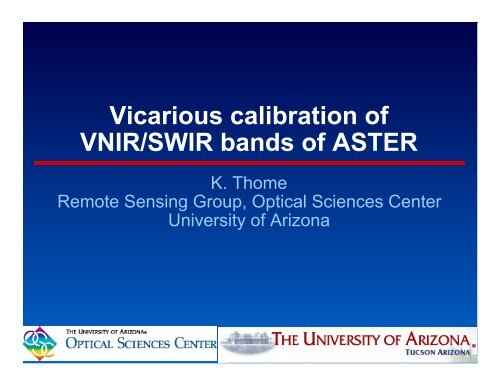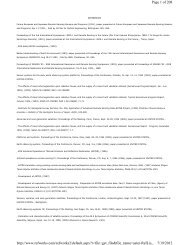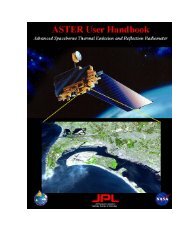Vicarious calibration of VNIR/SWIR bands of ASTER
Vicarious calibration of VNIR/SWIR bands of ASTER
Vicarious calibration of VNIR/SWIR bands of ASTER
You also want an ePaper? Increase the reach of your titles
YUMPU automatically turns print PDFs into web optimized ePapers that Google loves.
<strong>Vicarious</strong> <strong>calibration</strong> <strong>of</strong><strong>VNIR</strong>/<strong>SWIR</strong> <strong>bands</strong> <strong>of</strong> <strong>ASTER</strong>K. ThomeRemote Sensing Group, Optical Sciences CenterUniversity <strong>of</strong> Arizona
<strong>Vicarious</strong> Calibration<strong>Vicarious</strong> <strong>calibration</strong> is a radiometric <strong>calibration</strong>approach that does not rely on sensor-based devicesP The goal is to determine the relationship betweenincident spectral radiance and the sensor output! Independent <strong>of</strong> on-board calibrators (solar diffusersand lamps, for example) and pre-flight <strong>calibration</strong>! Deep space looks, lunar-based <strong>calibration</strong>sP Radiance validation is similar but it assumes that the<strong>calibration</strong> is already known! Preflight or onboard <strong>calibration</strong> gives the radiometric<strong>calibration</strong> and thus reported sensor radiance! Independent method predicts radiance at the sensor! If the predicted radiance matches the sensor radianceto within the uncertainties <strong>of</strong> the two methods, thesensor radiance is validated
Why bother with vicarious?Radiance validation is most critical for the accurateretrieval <strong>of</strong> geophysical parameters from temporaldata sets with little to no overlapP Realistically, absolute radiometric <strong>calibration</strong> may not beneeded for some specific cases! Data from a single sensor with focus on changeanalysis! Multiple sensors for which significant overlap existsP Temporal studies and inter-sensor measurements,however, critically require validated sensors! Biases between sensors need to be removed! Temporal changes in response must be trackedP Temporal studies using multiple sensors with little to nooverlap in data MUST have accurate absoluteradiometric <strong>calibration</strong>
Why bother with vicarious?Landsat-5 Thematic Mapper results from band 1show significant degradation after launch1.61.5Preflight1.41.31.2Ground-reference0 1 2 3 4 5 6Days since launchThousands
<strong>Vicarious</strong> approachesCurrent approaches for vicarious <strong>calibration</strong> includedterrestrial and extra-terrestrial targetsP Stellar targets have been attempted with mixed resultsP Lunar approaches have been successful for severalsensorsP Deep space looksP Ground/water/atmospheric reference approaches! Rayleigh/molecular scattering! Desert scenes! Melting snow fields! Sun glint over water! Cloud tops
U<strong>of</strong>A Reflectance-BasedRemote Sensing Group at University <strong>of</strong> Arizona reliesprimarily on a reflectance-based approachP Atmospheric characterization! Aerosol amount! Aerosol phase function and single scatter albedo! Column absorber amounts (water vapor and ozone)P Surface reflectance! Measurement <strong>of</strong> a preselected area from the ground! Use <strong>of</strong> airborne or satellite-based sensorP Input into a radiative transfer code to predict at-sensorradianceP Band-averaged over sensor spectral response andcompared to reported radiance from sensor
Reflectance-Based ApproachMeasuredSurfaceReflectanceMeasuredAtmosphericParametersAverage Test SiteOutput fromImageryRadiative Transfer CodeAt-sensorRadiancePredictedAt-sensor Radiance
Atmospheric Measurements
Surface reflectanceMeasure a large area <strong>of</strong> the test site related tonumerous pixels <strong>of</strong> the test sensorP Measurements <strong>of</strong> the upwelling radiance <strong>of</strong> the test siteare referenced to a standard <strong>of</strong> known reflectanceP Standard is characterized in the RSG’s laboratoryP Instrument is a commercially available spectrometer
Surface ReflectanceSpectral reflectance is the average <strong>of</strong> all data pointscollected over the entire siteP Area covered is 300 m by 80 mP Takes approximately30 minutes to collectthe data setP 480 spectra that areaverages <strong>of</strong> 20 samplesare collected! 8 spectra per 20 m! Reflectance standardsmeasured every64 spectra
Surface reflectance
Test sites
Railroad Valley Test Site
Ivanpah Playa test site
Lunar Lake test site
White Sands test site
Test site characteristicsTest site selection is the most important choice indetermining the uncertainties in reflectance-basedapproachP Goal is to understand the interaction between the surfaceand the atmosphereP Test site characteristics! High, flat spectral reflectance and nearly lambertian! Large geographic size with spatial uniformity! Low aerosol loading (high elevation)! Accessible and historical understanding <strong>of</strong> siteP Other choices such as radiative transfer code, aerosolmodel, instrumentation are also important! However, consistency <strong>of</strong> these will give good precision! Site selection will more dramatically impact theuncertainties and can increase the importance <strong>of</strong> theabove items
Spectral reflectance <strong>of</strong> test sitesIdeal surface is flat spectrallyP Removes uncertainty due to lack <strong>of</strong> knowledge in thesensor spectral responseP Allows for a direct comparison <strong>of</strong> sensors withoutspectral corrections
Recent results - ETM+Radiometric <strong>calibration</strong> <strong>of</strong> ETM+ has been shown tobe stable since launch using both the radiancevalidation and onboard calibrators63Avg + std. dev.Average DifferenceAvg - std. dev.0-3-6-9Band 1 Band 2 Band 3 Band 4 Band 5 Band 7
<strong>ASTER</strong> Reflectance-Based ResultsEvaluate <strong>ASTER</strong> <strong>calibration</strong> using both the Level 1Band the Level 1A data setsP The comparison to the Level 1B data indicates theabsolute accuracy <strong>of</strong> the radiometric <strong>calibration</strong>! Level 1B data have been radiometrically corrected! Rescaled to allow conversion to radiometric unitsP Level-1A data analysis allows us to evaluate the trend <strong>of</strong><strong>calibration</strong>! Determine the degradation <strong>of</strong> the sensor to betterunderstand its radiometric properties! Understand how well the onboard calibrators areoperatingP Level 1A data are examined using the <strong>ASTER</strong> output(counts) compared to predicted radiance from thevicarious method
<strong>ASTER</strong> Band 1P Level 1B data do notshow a strong temporalsignal but do show asignificant biasP Level 1A data do show adegradation that appearsto have leveled outrecently-4-6-8-10-12-14-16Level 1B1.05Level 1A10.950.90.85100 200 300 400 500 600 700 800 900 1000 1100Days Since Launch1.31.21.110.9-180 200 400 600 800 1000<strong>ASTER</strong> < <strong>Vicarious</strong> for positive valuesDays Since LaunchAverage and one std. dev.0.80 200 400 600 800 1000Days Since Launch
<strong>ASTER</strong> Band 2P Level 1B similar toBand 1 data and do notshow a strong temporalsignal but do show asignificant biasP Level 1A data do showa degradation smallerthan Band 1-8-10-12-14-161.0510.950.90.85100 200 300 400 500 600 700 800 900 1000 1100Days Since Launch1.151.11.051-18-20-22-24<strong>ASTER</strong> < <strong>Vicarious</strong> for positive valuesAverage and one std. dev.0 200 400 600 800 1000Days Since Launch0.950.90.850 200 400 600 800 1000Days Since Launch
<strong>ASTER</strong> Band 3P Level 1B similar toBand 1 data and do notshow a strong temporalsignal but show a biasP Level 1A data show asmall degradation0-5-10-151.151.11.0510.950.90.85100 200 300 400 500 600 700 800 900 1000 1100Days since Launch1.151.11.0510.95-20-25<strong>ASTER</strong> < <strong>Vicarious</strong> for positive valuesAverage and one std. dev.0 200 400 600 800 1000Days Since Launch0.90.850 200 400 600 800 1000Days since Launch
<strong>SWIR</strong> <strong>bands</strong>Graphs below show Level 1B results for Bands 4, 5,6, and 7105<strong>ASTER</strong> < <strong>Vicarious</strong> for positive valuesAverage and one std. dev.2010B500-5-10-10-150 200 400 600 800 1000Days Since Launch-20<strong>ASTER</strong> < <strong>Vicarious</strong> for positive valuesAverage and one std. dev.0 200 400 600 800 1000Days Since Launch2520<strong>ASTER</strong> < <strong>Vicarious</strong> for positive valuesAverage and one std. dev.B62520<strong>ASTER</strong> < <strong>Vicarious</strong> for positive valuesAverage and one std. dev.B7151510105500-50 200 400 600 800 1000Days Since Launch-50 200 400 600 800 1000Days Since Launch
1.05Summary <strong>of</strong> resultsGraphs below show the average percent differencebetween the vicarious results and the Level 1BradiancesP Results from ETM+ and MODIS are also shown10.95P Dates are not all identicalP <strong>SWIR</strong> crosstalk effect is evidentP <strong>VNIR</strong> bias also visible1.41.31.2MODISETM+<strong>ASTER</strong>0.90.85MODISETM+<strong>ASTER</strong>0.8400 500 600 700 800 900Wavelength (nm)1.110.91200 1400 1600 1800 2000 2200 2400Wavelength (nm)
Solar irradiance modelA solar irradiance model is used to convert theradiative transfer code results to absolute radianceP Selection <strong>of</strong> solar model has no impact on <strong>ASTER</strong> Level1B radiance! For ETM+, ALI, MODIS, and others, the solar model isimportant since these sensors have solar diffusers! AVIRIS has “forced” the MODTRAN model to match itslaboratory <strong>calibration</strong>P The two places where the solar model impact <strong>ASTER</strong> arein the vicarious <strong>calibration</strong> and atmospheric correctionP Must have consistency between the vicarious <strong>calibration</strong>and atmospheric correction if vicarious <strong>calibration</strong> is usedto adjust <strong>calibration</strong> coefficientsP Will be problems when a user decides to atmosphericallycorrect their own data using an inconsistent solar model
Solar irradiance model effectsP <strong>ASTER</strong> team uses a solar model called the WRC modelP Typical model used by the community is MODTRANP Graph below shows the % difference between the two for<strong>ASTER</strong> <strong>bands</strong>43.120-2-0.10.3 0.3-4-6-4.4-8-10-7.9-9.3-8.2-12-11.2Band 1 Band 2 Band 3 Band 4 Band 5 Band 6 Band 7 Band 8 Band 9
Effect on vicariousP Graph shows the average percent difference between thevicarious and <strong>ASTER</strong> dataP <strong>Vicarious</strong> determined using both MODTRAN and WRCP Bands 4 and 5 are interesting in that Band 5 is“calibrated” when considering WRC results but notMODTRAN and vice versa for band 420151050-5-10-15-20Band 1 Band 2 Band 3 Band 4 Band 5 Band 6 Band 7 Band 8 Band 9WRC-basedModtran-based
AVIRIS predicting sensor radianceShows % difference between AVIRIS & <strong>ASTER</strong> atsensorradiances for Railroad Valley -June 30, 2001P AVIRIS data band-averaged to <strong>ASTER</strong> spectral responseP Band 9 omitted because insufficient AVIRIS <strong>bands</strong> tocover full response <strong>of</strong> <strong>ASTER</strong> band151050-5-10-15-20B1 B2 B3 B4 B5 B6 B7 B8
Direct comparison resultsP There exist several days <strong>of</strong> coincident ground data alongwith MODIS and <strong>ASTER</strong> dataP Can calibrate both sensors using the same site at RRVplaya! 1 km 2 area <strong>of</strong> Railroad Valley used for both sensors! Same radiative transfer code inputs and resultsP Dates shown here were from May 16 and June 14, 2002P Band 1 <strong>of</strong> <strong>ASTER</strong> had saturated pixels within the site inboth casesHigh-ResolutionTest SiteLowResolutionTestSite
Coincident MODIS dataUsing <strong>ASTER</strong> and MODIS data from the same sitefor May 16 and June 14, 2002 are shown belowP Both dates show consistent results for MODIS in all<strong>bands</strong> and for <strong>VNIR</strong> <strong>bands</strong> <strong>of</strong> <strong>ASTER</strong>P Band 1 <strong>of</strong> <strong>ASTER</strong> was saturated on both datesP Note the bias isstill present inBand 2 andto lesser extentBand 3P <strong>SWIR</strong> crosstalkeffect also apparentP Difference betweendates in the <strong>SWIR</strong>is under investigation20100-10-20<strong>ASTER</strong>MODIS0.5 1 1.5 2Wavelength (micrometers)
Cross-comparison in reflectanceCan also atmospherically-correct data to reflectanceand then compare in reflectanceP Radiance comparisons work when overpasses arenearly coincidentP Other cases require acorrection for atmosphericdifferences and geometryP Instead compare surfacereflectanceP Atmospheric correction basedon measured atmospheric400.2 0.3 0.4 0.5 0.6Surface Reflectanceconditions as input to a radiative transfer code for tworepresentative reflectancesP Linear interpolation from a known radiance gives thesurface reflectance1201008060ETM+ Band 1ETM+ Band 4Reported ETM+ RadianceInterpolated Surface Reflectance
Cross-comparison resultsSummary <strong>of</strong> retrieved reflectance <strong>of</strong> Argentinianplaya (El Leoncito) in Jan. 2001 for given sensors0.70.60.50.40.30.2ALI<strong>ASTER</strong>ETM+HyperionAVIRIS <strong>ASTER</strong>AVIRIS ETM+0.5 1 1.5 2 2.5Wavelength
Cross-comparison resultsComparison <strong>of</strong> <strong>VNIR</strong> <strong>bands</strong> for similar overpasstimes <strong>of</strong> El Leoncito0.50.50.40.40.3<strong>ASTER</strong>AVIRIS <strong>ASTER</strong>0.20.4 0.5 0.6 0.7 0.8 0.9Wavelength0.3ALIETM+HyperionAVIRIS ETM+0.20.4 0.5 0.6 0.7 0.8 0.9Wavelength
ConclusionsP <strong>ASTER</strong> <strong>VNIR</strong> <strong>bands</strong>! Bias in the Level 1B radiance! Level 1A results are beginning to diverge from theonboard calibrator results! Gaps will be filled with comparisons to MODISP <strong>ASTER</strong> <strong>SWIR</strong> <strong>bands</strong>! No strong temporal degradation! Crosstalk effect is large enough over vicarious sites tocause confusion in interpreting <strong>bands</strong> 5-9! Bands 4 and 5 could be susceptible to error whendoing own atmospheric correctionP Cross-comparison to other sensors shows similar resultsas the reflectance-based <strong>calibration</strong>s! <strong>ASTER</strong> <strong>VNIR</strong> <strong>bands</strong> are not consistent with manyother EOS sensors! <strong>SWIR</strong> data require a cross-talk correction
ConclusionsP Reflectance-based accuracy is approaching 3% in visibleand near infraredP Precision is near 2% in the <strong>VNIR</strong> [1-F]P Further improvements to precision will be found byevaluating all aspects <strong>of</strong> the problem! Understanding <strong>of</strong> field instrumentation! Greater frequency <strong>of</strong> field collections! Evaluations <strong>of</strong> the radiative transfer codesModelsAnswerFieldDataLaboratoryCharacterization
ConclusionsP Current level <strong>of</strong> precision is adequate for trending if doneat greater frequency! 12 times per year (that’s successful collections)! Onboard systems provide better frequency andprecisionP Improvement in precision allows trending with fewercollections per yearP Once precision is reduced, then it is possible todetermine biases! Cross-comparison work gains further confidence! Apply approach to a greater number <strong>of</strong> data setsP These types <strong>of</strong> data sets as well as others (lunar view,additional sites) will be critical over the next 12-24months to evaluate the onboard calibrators and crosstalkcorrection s<strong>of</strong>tware





